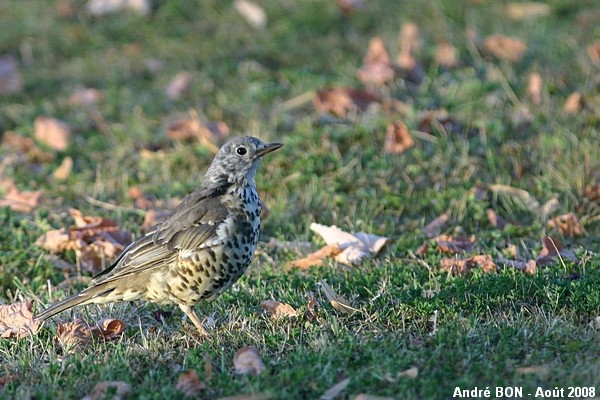
| Mistle Thrush (Turdus viscivorus (Linnaeus,1758)) |

|
|
Scientific name: Turdus viscivorus (Linnaeus,1758) Common name: Mistle Thrush Other names: Mistletoe Thrush, Missel Thrush. French name: Grive draine, Grive du gui, Grive viscivore Order: Passeriformes Family: Turdidae Size: Body size: 27 cm; Wingspan: 42 to 47 cm; Weight: 110 to 140 g. Habitat: Open habitats with trees in the vicinity, bocage, woodland edges, clearings. Food: Insects, worms and berries picked on the ground or picked in trees or shrubs. Nesting: The nest is a large cup located high in a tree or in a shrub. There are two broods of 3 to 5 eggs between mid-march and late July. Migration: Partially migratory. Northern populations move southwards in winter. Geographic area: All Europe and Asia east to central Siberia, North Africa. You can distinguish 3 subspecies, Turdus viscivorus viscivorus in Europe east to the Urals, Turdus viscivorus bonapartei east of the Urals to central Siberia and Turdus viscivorus deichleri in North Africa. |
The Mistle Thrush is the largest Thrush. The upper side of the plumage is brown with grey areas on the head, on the back and on the upper side of the tail. This enables to tell it apart from the Song Thrush. The under side and the sides of the body are yellowish brown mottled with black spots. These black spots are more irregularly placed and do not show V-shaped lines as we can see on the Song thrush breast. The underside of the wings, visible in flight, are a bright white colour. Mistle Thrushes live alone or in pair and gather in small family flocks during the bad season. The Mistle Thrush feeds on Mistletoe berries (Viscum album) and then is a key disseminator for this plant. |
| [To know more about the Mistle Thrush] [Top] |

|
Work meetings that end late in the evening do not have only drawbacks. They enable to observe new bird species near the company parking lot. The camera was in the car. I drove towards the small flock of Mistle Thrushes landed on the lawn. I shot this picture through the car window, this explains the poor quality. As soon as I started to roll the window down the whole flock flew away. |